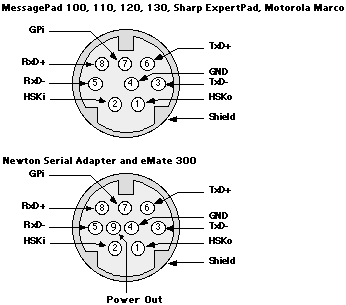
http://www.newton-inc.com/dev/techinfo/qa/qa.htmPin 1 HSKo /DTR
Pin 2 HSKi /CTS
Pin 3 TxD- /TD
Pin 4 GND Signal ground connected to both logic and chassis ground.
Pin 5 RxD- /RD
Pin 6 TxD+ (see below)
Pin 7 GPi General purpose input received at SCC's DCD pin.
Pin 8 RxD+ (see below)
Pin 9 Power out 5V@100ma. This pin only exists on the eMate 300 and the Newton Serial Adapter.
